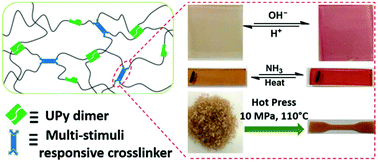Bio-inspired self-healing polyurethanes with multiple stimulus responsiveness†
Abstract
High-performance stimuli-responsive polymers that exhibit spontaneous, sophisticated and reversible responses to a wide range of external stimuli are highly desirable for applications in diverse fields and have attracted dramatic attention in recent decades. However, it still remains a great challenge to precisely design molecular architectures which can integrate multi-stimuli responsive functions into one structure in polymeric materials. In this study, we reported the synthesis and preparation of a novel multi-responsive self-healing polyurethane with superior mechanical properties by adapting a stimuli-responsive dynamic covalent chemical crosslinker and a biomimetic modular polymer design. This unique crosslinker was synthesized through the Michael addition reaction between thiols and bismaleimides, making the chemically crosslinked polyurethanes healable and recyclable at an elevated temperature as well as stimuli-responsive to heat, pH and ammonia gas. A visible color change can be clearly observed when the polymer is in the base or ammonia gas environment, giving the sample great potential for being a gas or pH sensor. Furthermore, the incorporation of self-complementary quadruple hydrogen bonding interactions between 2-ureido-4-[1H]-pyrimidione (UPy) motifs in the polyurethane backbone chains enables the formation of modular hydrogen bonding domains, endowing the material with enhanced mechanical properties.



 Please wait while we load your content...
Please wait while we load your content...